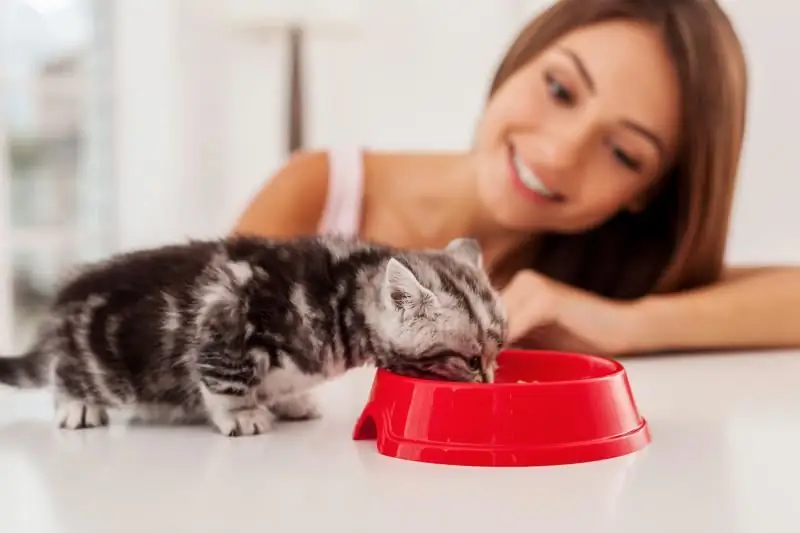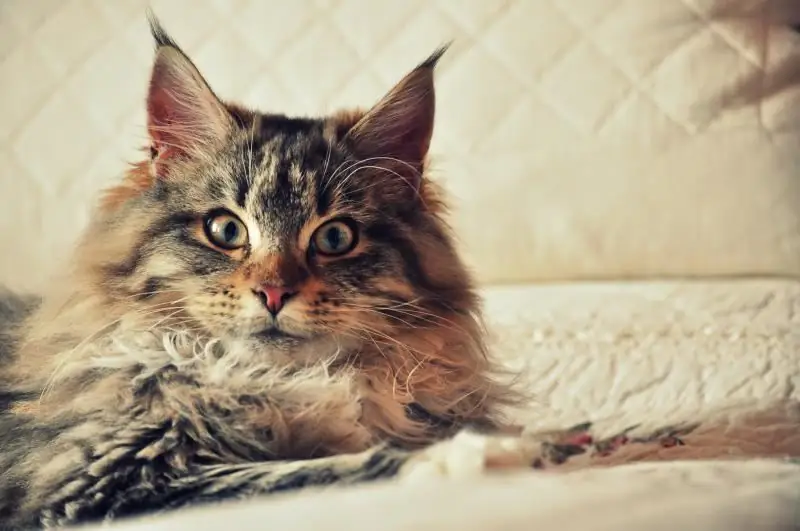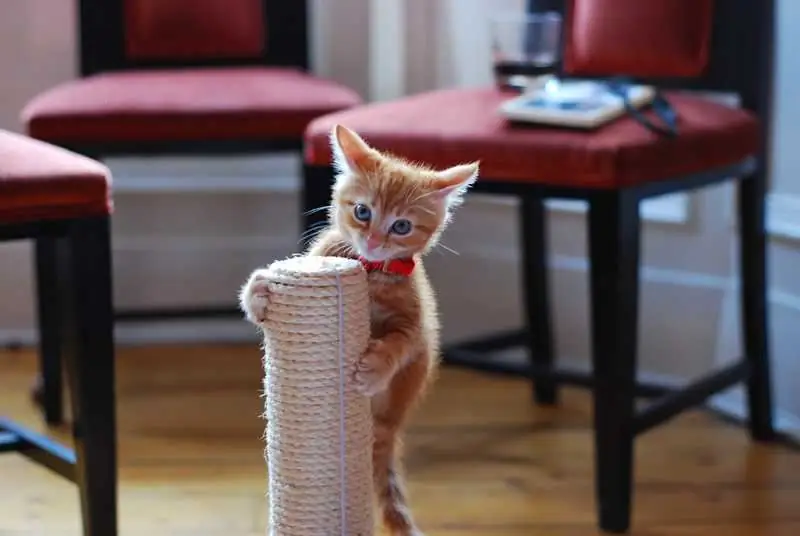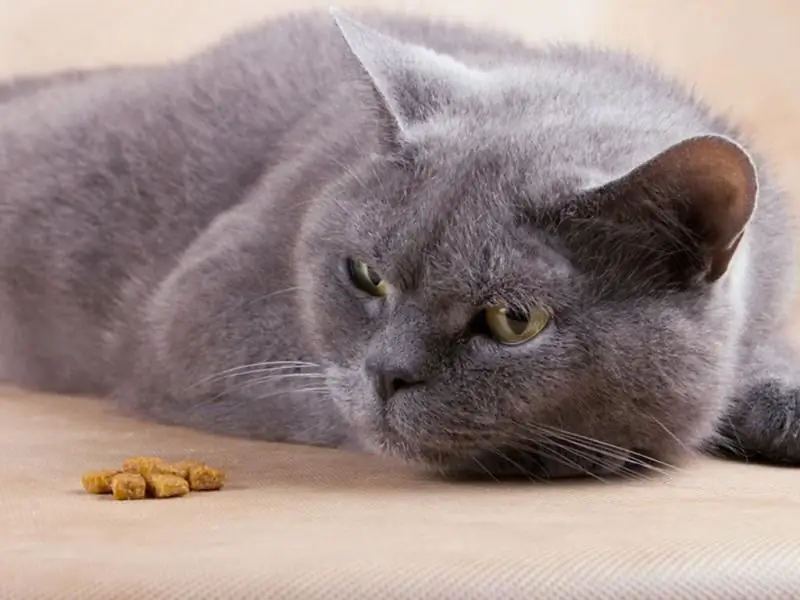
Table of contents:
- Author Bailey Albertson [email protected].
- Public 2024-01-17 22:26.
- Last modified 2025-06-01 07:32.
How to teach a kitten to a bowl

Self-feeding is an important stage in every kitten's maturation. Nutrition of a baby in childhood lays the foundation for his health for the rest of his life, and it is not always possible to correct the adverse consequences of eating disorders.
Content
-
1 Nutritional features of a newborn kitten
- 1.1 Growth rate of a kitten
-
1.2 Feeding in the absence of the mother cat
- 1.2.1 Video: how to prepare a mixture for kittens at home
- 1.2.2 Photo gallery: ready-made formula for feeding kittens
-
2 Organization of self-feeding
- 2.1 At what age do kittens begin to eat themselves
- 2.2 How to determine the readiness of a kitten
- 2.3 Bowl Training Rules
- 2.4 Video: kittens' first feeding
- 2.5 Diet during the transition period
- 2.6 Drinking regime
- 3 Reasons for refusing food
- 4 Advice from veterinarians
- 5 Cat owner reviews
Nutritional features of a newborn kitten
For the first weeks of its life, the kitten feeds on the milk of the mother-cat. Normally it contains:
- all essential nutrients;
- trace elements;
- antibodies that form colostral immunity in a kitten, making it immune to pathogens of many diseases during breastfeeding.
The first days of breastfeeding, the kitten receives colostrum. It is this that ensures the formation of colostral immunity, while the milk, which replaces colostrum after a few days, contains high titers of antibodies that are involved in the formation of local immune protection in the lumen of the intestinal tube, but can no longer penetrate into the systemic circulation of the kitten (this is possible only on the first day after the birth of a kitten).
Feeding the milk of a mother cat ensures a normal growth rate in kittens and is most acceptable for the owner, since it practically does not require human participation. Breastfeeding is performed by the cat within 40-60 days after the birth of kittens.
Kitten growth rate
A kitten's growth rate is an important indicator of its health and development. At birth, a kitten weighs 110-125 g and doubles it by 7-9 days of life. A five-week-old kitten weighs 450 g, a ten-week-old kitten - 900 g. The baby must constantly gain weight, if this does not happen, a thorough examination is necessary. Therefore, the first two weeks of life of kittens is recommended to be weighed daily, and at the age of 2-4 weeks - every three days. On average, a kitten should gain 10 g every day.

Mother-cat's milk is the best food for a little kitten
Feeding in the absence of the mother cat
When breastfeeding is not available, the owner of a cat and kittens faces a whole range of problems, since the mother cat provides not only feeding, but also warming the kittens, grooming, helps in the administration of physiological needs, stimulating urination and defecation. In the future, the cat teaches kittens to communicate, forms their self-determination, teaches them to use the litter box. The role of a mother cat is invaluable, and if she cannot feed and raise kittens, another lactating cat would be the ideal way out of the situation. In its absence, the owner will have to artificially feed the kittens, and also take full responsibility for the hygiene and socialization of the babies.
Cat milk is unique in its composition. It contains 2 times more protein than cow's milk. The latter is not suitable for feeding kittens, it causes digestive disorders and diarrhea. Therefore, taking into account the labor costs that will have to be invested in the cultivation of kittens deprived of their mother, the use of ready-made veterinary artificial mixtures - milk substitutes looks optimal. They are available in veterinary stores and are as close as possible in composition to a cat's breast milk. In addition, they are easy to use, and also save the owner from dangerous experiments with the preparation of milk mixtures with the addition of raw chicken eggs, which can be infected with microbial pathogens.
Video: how to prepare a mixture for kittens at home
Reliable and breeder-tested products include:
- Beaphar Kitty Milk - the mixture is intended for feeding kittens up to the age of 1 month;
- Royal Canin Babycat Milk - to meet the needs of a kitten up to 2 months of age;
- Kittenmilch cdVet - a mixture made with the addition of colostrum;
- Nutri-Vet Kitten Milk - can be used both for feeding kittens and for additional feeding of a lactating cat if breastfed kittens are gaining little in weight.
Photo gallery: ready-made formula for feeding kittens
-

Beaphar Kitty Milk -
Beaphar Kitty Milk contains all the essential nutrients, fats, amino acids, vitamins, minerals and trace elements in the right ratio
-

Kittenmilch cdVet - Kittenmilch сdVet - milk replacer for kittens with colostrum
-

Nutri-Vet Kitten Milk - Nutri-Vet Kitten Milk is fully adapted to the needs of newborn kittens and pregnant cats
-

Royal Canin Babycat Milk - Royal Canin Babycat Milk is formulated with extremely digestible proteins
It is good if the owner of the kittens, who has realized his position, does not get confused and contacts the cattery by phone. There may be frozen colostrum, which is extremely important for kittens to receive on the first day after birth.

If breast milk is unavailable, veterinary formula substitutes are used for artificial feeding.
Kittens fed preheated to 38 on C dairy mix. They keep the kitten in a supine position with its abdomen turned down, otherwise the mixture may enter the respiratory tract, which can be fatal.
Frequency of feeding kittens, including those already transferred to independent feeding:
- 1 week - every 2 hours, at night too;
- 2 week - every 3 hours without a break at night;
- 3 week - 6 times a day, with a break of 5 hours at night; by this time, babies are already receiving complementary foods;
- from the 2nd month, the kitten is fed 5 times a day;
- from the 3rd month - 4 times a day;
- from the 5th month - 3 times a day.
Organization of self-feeding
Accustoming a kitten to self-feeding usually begins from the 3rd week. Experienced breeders consider the 25th day to be the optimal time.

Experienced breeders recommend starting to feed kittens from the 25th day.
At what age do kittens begin to eat themselves
Usually, from the age of 3 weeks, the kitten is already lapping the milk mixture from the saucer, from 4 weeks of age, if you plan to transfer it to dry food, you can offer him granules for kittens, soaking them in the milk mixture, or wet food. At the same time, the baby continues to feed on breast milk or artificial formula.
How to determine if a kitten is ready
Under normal conditions, cat's milk production decreases from 4 weeks. She begins to avoid kittens and is absent from the nest for a long time, and babies begin to instinctively look for additional food sources. By this time, the kittens are already moving independently, orienting themselves on the terrain and have milk teeth. In most cases, the cat makes it easier for the owner by bringing the kittens to their place of feeding - to the kitchen. If kittens do not start feeding, they will lose their growth rate, lose weight and become loud as they begin to starve.
Bowl training rules
It is better to teach kittens to a bowl together so that they develop normal socialization:
- Calculate the volume of the required milk mixture, focusing on the instructions for it and the number of single portions.
- 2 hours before feeding, the cat is removed from the kittens to improve their appetite.
- They suggest that the kitten lick a finger moistened with the milk mixture, or place a small amount of the mixture on the kitten's tongue with a teaspoon, making sure that he begins to lap on his own. You can't dip a kitten's face in a saucer - it can inhale milk with the subsequent development of pneumonia. It should also be borne in mind that cats' noses are very sensitive, and the painful sensations obtained when training to a bowl can, on the contrary, turn away from it.
- After feeding with the mixture, the cat is returned to the kittens for supplementary feeding.
Self-feeding should be gradual, while kittens should be able to feed with breast milk.
Video: kittens' first feeding
Solid food is introduced when the kitten already knows how to lap from a saucer:
- Wet food: mix two thirds of wet food for kittens with one third of the milk mixture, the food should be at room temperature.
- Dry food: one part dry kitten food is mixed with three parts milk formula; over time, the amount of liquid in the food is gradually reduced, so that from 5-6 weeks the kitten can only eat slightly moist food, and from 8-10 weeks - completely dry baby food.
- With a natural type of food, the kitten is offered milk oatmeal or chicken or beef meat (a lump of boiled minced meat is not larger than a pea). Complementary foods are introduced in small portions; It is recommended to start adding a new product after 2 weeks of starting complementary foods no more often than 1 new product in 3 days. After the introduction of a new product, the condition of the kitten is monitored especially carefully. For good nutrition with natural products, you should accustom your kitten to a variety of foods.

If the baby does not understand how to eat from the saucer, you can help him by putting food in his mouth with a spoon.
During the introduction of complementary foods, there is a risk of diarrhea in kittens. Its causes are most often:
- binge eating;
- poor assimilation of the product introduced as complementary foods.
With the development of diarrhea, you should:
- cancel the introduced product before the end of the diarrhea;
- reduce the number of feedings with already introduced products;
- increase the proportion of mother's milk in the kitten's diet - until the stool is normalized;
- after stool normalization, re-offer the kitten a new product.
Diet in the transition period
The diet during the introduction of complementary foods depends on whether the owner is going to feed the kitten with ready-made industrial food or natural food in the future. If you plan to use ready-made feed, then you should choose a product for kittens produced by a trusted manufacturer:
- Orijen;
- Royal Canin;
- ProPlan;
-
Eagle Pack Holistic Select.

Kitten food For kittens, you should choose high quality dry food that fully meets the needs of a growing body
Good food for kittens can only be purchased at specialized veterinary stores and veterinary pharmacies. When buying feed, you should not save on its composition, but avoiding retail markups, for example:
- buy food in an online store and carry out its own pickup;
- purchase feed by joining the nursery order, since there are discounts there;
- join one of the social media groups curated usually by salespeople giving the group a discount for wholesale.
Having purchased feed, you should always pay attention to its expiration date, and also take into account that a month after opening the bag, it loses its quality even with proper storage. You can never buy food by weight - since it is not clear when the bag was opened, whether there is any infection with microbial pathogens.
When feeding kittens with ready-made food, manufacturers recommend using both dry and wet food. Vitamin and mineral supplements are not necessary for kittens receiving super premium food. When determining the portion for a single feeding, they are guided by the feed annotation.

For feeding kittens, products from trusted manufacturers are used.
With natural nutrition of a kitten, for introduction into its diet, use:
- boiled finely chopped meat or minced meat from lean beef, chicken, turkey, rabbit;
- boiled fish without bones;
-
dairy:
- skim cheese;
- yogurt;
- yogurt;
- kefir;
- eggs, especially quail eggs;
- porridge made from rice, buckwheat, millet cooked in milk or broth;
- vegetables that are boiled are broken with a blender and added to the kitten's food.
With natural nutrition, the kitten needs vitamins and mineral supplements, which are prescribed by a veterinarian. For the first four months of a kitten's life, he definitely needs dairy and fermented milk products, which serve not only as a source of nutrition, but also prevent the development of intestinal dysbiosis. At the age of 5 months, the kitten can be switched to the diet for adult cats, keeping 3 meals a day. The total amount of food for a kitten per day should be 10% of its weight.

Up to 4 months kittens need the presence of dairy and fermented milk products in the diet
There are some peculiarities when transferring a kitten to self-feeding and using natural products:
- From the 9th week of a kitten's life on a natural diet, they begin to gradually increase the content of solid foods, while the meat and vegetables are finely chopped, minced meat is no longer given. The porridges are still liquid. Half of the entire diet should be fermented milk products and milk.
-
At the age of 3 months:
- reduce the content of fermented milk products to one quarter of the diet, remove milk;
- meat and vegetables are cut even more coarsely;
- boil porridge thicker;
- offer the kitten raw vegetables (carrots, zucchini, potatoes).
- At 4-5 months, solid food completely replaces liquid cereals; the consistency of vegetable and cereal dishes should be close to thick rustic sour cream.
Drinking regime
Kittens should have free access to clean drinking water, which is poured into small bowls, preferably saucers. The water is changed several times a day. The kitten's drinking water bowl should have a permanent place so they know where to find it.
In the absence of water, the kitten quickly develops a dangerous condition - dehydration, which is characterized by:
- weight loss;
- dry mucous membranes;
- brighter color of visible mucous membranes;
- a decrease in the turgor of the skin - if you pinch the skin, the resulting fold does not straighten (check at the withers).
Elimination of dehydration:
- identification and elimination of its cause;
- providing a kitten with breast milk;
- if necessary, subcutaneous injections of isotonic solutions (5% glucose solution, 0.9% sodium chloride solution in volumes agreed with the veterinarian).
Reasons for refusing food
Refusing to eat a little kitten is always a very serious cause for concern. The kid requires an examination by a veterinarian who is called at home. In newborn kittens, the cause may be:
- Intrauterine developmental disorders.
- Injuries sustained during childbirth, as well as from being crushed by an inexperienced cat.
- Low birth weight due to placental insufficiency in a cat - such kittens should be artificially fed, otherwise they will die.
- Intrauterine infection, such as chlamydia or feline leukemia virus.
- Hypothermia (low body temperature) - when keeping cats and kittens in a cold room, and especially when feeding kittens without a cat. With hypothermia, it is impossible to feed the kitten, since its digestive system does not function. The baby is gradually warmed up by giving him a pedialitis solution or 5% glucose solution at the rate of 1 ml of solution per 30 g of the kitten's weight per hour, making the kitten appear active. Hypothermia is very dangerous, therefore, the temperature in the den should be maintained at 29-32 o C, reducing it by 2.5 o C every week until it reaches 21 o C. To warm the den, lamps are placed above it, and heating pads are also used. This is usually necessary if the cat is not present or she refuses to be with the kittens.
- Neonatal isoerythrolysis (hemolysis of newborns) is a condition when antibodies obtained from a cat's colostrum attack the kitten's erythrocytes, manifested by the development of jaundice. The kitten can be saved by transferring to artificial feeding for 2 days, and then returning to the cat. The condition is caused by a mismatch between the blood groups of a cat and a kitten, an analogue is the Rh-conflict in humans. The difference is that in primates, the transmission of antibodies occurs through the placenta, and the course of the Rh conflict is intrauterine. In cats, the transmission of antibodies occurs with milk, so this condition is easier to suppress, since the penetration of maternal antibodies into the blood through the intestinal wall of a kitten is possible only in the first 24 hours of its life.
In kittens that previously developed normally, the reason for refusing to eat may be:
- helminthic invasion;
- infection;
- in some cases, with the introduction of solid food and a shortage of drinking water, the kitten may experience constipation, which reduces appetite.
Veterinarian advice
Cat owners reviews
Feeding a cat's breast milk is essential for the full growth and development of a kitten. If breastfeeding is not available, you should use ready-made veterinary cat milk replacers. From the fourth week, the amount of mother's milk begins to decrease, and kittens should be fed first with liquid food, using a veterinary milk replacer, and then solid food. When switching to self-feeding, it is extremely important that the kitten has free access to drinking water, since the risk of dehydration is high. All reasons for refusing to eat in kittens require immediate examination by a veterinarian at home.
Recommended:
Maine Coon: Description Of The Breed, Character And Habits, Maintenance And Feeding, Weight By Month, Photo With A Person, Approximate Price, Reviews

Everything you need to know about the largest domestic cats: the history of the Maine Coon breed, its features, caring for animals and their breeding
How To Train A Cat Or Cat To A Scratching Post, Including In The Form Of A House: Features Of Training Kittens And Adult Animals, Recommendations And Reviews

Why cats need to sharpen their claws. How to draw your pet's attention to a device. What to do if your cat doesn't want to use the scratching post
A Cat Or Cat Does Not Eat Or Drink Water For Several Days (3 Or More): Reasons For Refusing To Eat And Drink, What To Do If The Kitten Suffers

How dangerous is the refusal of food and water. What diseases can cause similar symptoms in cats? What to do if the animal does not eat or drink
Why Does The Cat Eat Next To The Bowl

Reasons why a cat takes food out of a bowl and eats it off the floor
Stars Who Prefer To Clean Their Homes On Their Own

Russian stars who fundamentally do not use the services of housekeepers and run the household themselves
